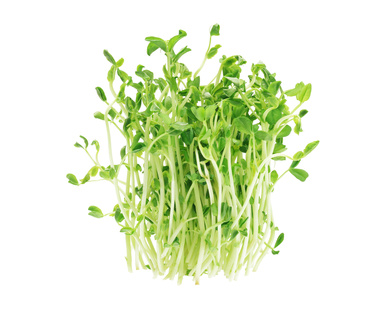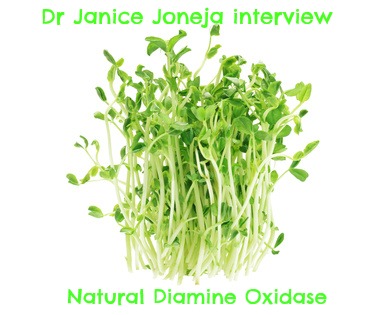A number of years ago immunologist and researcher Dr Janice Joneja had a brilliant idea: to extract the histamine-lowering diamine oxidase enzyme from natural (vegan) sources, to help those of us with histamine intolerance to lower histamine naturally.
This was such a long time ago, a time when histamine intolerance and other related histamine/mast cell disorders were even less diagnosed and understood than they are now, and so she wasn’t able to interest anyone in funding research.
(She does tell me though that in 2006/7 an Italian group applied for a patent on a DAO extraction process, but they never did anything with it. The person who diagnosed me was also working on a pea based DAO supplement that never came to market.)
Just recently I was lucky enough to receive an email from her, detailing how those of us at home, who are unable to tolerate commercially available diamine oxidase (DAO), can come up with our own DIY diamine oxidase supplement from natural sources. (You can read it here).
Basically, a number of legumes have especially high levels of diamine oxidase (DAO). According to Dr Joneja (and my own experience) home sprouting and consuming these is a really easy way to get a natural diamine oxidase fix, without the exorbitant cost. Not to mention not having to ingest a bunch of nasty fillers. In my case, I always try to get my medicine from food, so I can was totally over the moon to hear about this.
What Dr Joneja would like to do is get enough feedback from a group of us (ideally at least a thousand), in order to put together a study so that we can try and get some accurate statistics on dosage and growing methods. If you’d like to be part of this exciting project, please join a lovely little Facebook group I put together here. It’s a closed group so all postings are private and we’re all sharing our results and methodology there.
Many of you had questions about the process, so I put them all together and scored another interview with the lovely doctor of infinite patience.
Read the transcript below…
Listen to the interview here.
Right click here to download the interview mp3 (opens in iTunes).
Which other peas or beans would also have diamine oxidase? Is it just the green peas?
Legumes. And the legumes are different from each other. It would be the seedlings in each case, because the diamine oxidase is actually functions in helping the plant to make its structural components, like the stem, when the seed is developing, so that’s the function of diamine oxidase in the plant. The other ones that one could try are lentils, and chickpeas. The diamine oxidase seems to be produced, from the literature, about three days into the development of the pea or seedlings, and then goes on and reaches a maximum at about 10 days and then it will decrease because it’s no longer needed. We find, from the literature, that diamine oxidase, is a protective enzyme, both for the human (that would be in the placenta of course) and in the plant, so when the plant is under stress, it produces more diamine oxidase. So if a plant develops under stress, in darkness for example, rather than the light, it becomes what we call etiolated, but the diamine oxidase is about five times higher, if not more, than the concentration you would find in a seedling developing in the light.
So actually, if a person wanted to go that route themselves, what I would recommend is to grow the seedlings yourself, in the dark, so put it in a seed bag or whatever and put it in the dark, for about 10 days, no later, then harvest the seedlings and use them more or less in the same way, as a smoothie, rather than eating them as they are because the diamine oxidase is attached to the cell wall. It’s there to help the plant make the cell wall, if you put it in a blender and blend up these seedlings, you will find that it is much more readily available to you.
So that would be five times, if not more, the diamine oxidase content of the seedlings than if it had just been grown in.
Does it matter if they’ve been soaked and sprouted or grown in soil?
You can grow them in soil of course but it’s much easier to do it in water, and much cleaner too. You don’t want to have bacteria, contamination from the soil, because you do not sterilise them. If you do, if you heat them, you’re deactivating the diamine oxidase enzyme, which is a protein. So I would definitely not recommend growing in soil.
I’ve got a three level sprouter, you add a layer of sprouts, a layer of water, but actually you can buy mechanical sprouters where the water filters down automatically.
Ready bagged sprouts I know have varying histamine levels, is buying those something you would think is ok?
Those would be ok, but ideally, one that was grown in the dark, commercially to have a higher level of diamine oxidase, would be better.
How about pea sprout powder? Does quantity mean more DAO?
Well, when you buy sprouts commercially, you’ll see they’re nice and green and healthy looking, the ones you’d want to put into your salad – they have a much lower concentration of diamine oxidase, they just have what’s needed to help them grow to that level. When they’re in the dark and struggling to grow, they’re not green, they don’t look healthy but they have a much higher level of diamine oxiase because the plant’s trying to grow.
Are we talking about spoons, cups per day? What kind of “dosage” are we looking at ideally?
It’s very hard to say exactly how much is actually in that plant. The research indicates that up to 4% of the total protein content of the seedlings can be diamine oxidase. Being a protein, it’s also subject to digestion and then of course the diamine oxidase itself will be broken down in the process of protein digestion, so it’s a matter of seeing how much can be absorbed and how much of it is still active. But it is still absorbed in the small intestine, so it doesn’t have the entire length of the digestive tract to exposed to digestive enzymes.
It’s hard to say you need a cupful a day, but if one could try that, and then that could be our experiment, to find someone who does well with one cupful a day, and see what they measure as their optimum amount.
Well, I can tell you we’ve already had a few successes, in what, just over 10 days or so.
That’s great news because in my practice I’ve always told people to avoid supplements as much as possible, to use real foods as much as you possibly can, because the human race has for millennia survived on real foods and I don’t like supplements.
Absolutely! The people who have done really well, one of them has been juicing them, she said that as soon as she started juicing a cup full a day, she’s noticed an incredible improvement.
That’s exactly right – juicing, because then you get the diamine oxidase away from the stems and it will be much more readily available.
And we have another person reporting an incredible upsurge in energy and a few other positive reports coming in.
I’m so happy to hear that, because it’s so much better than waiting for some commercial operation to put it on the market.
I know, that for a lot of people, the problem is that the supplements are derived from pork, which is either a religious issue or a health one, but those who are salicylate intolerant have been asking me if they find the DAO in meat rather than high salicylate sprouts.
Diamine oxidase is concentrated in certain organs. So it won’t be in the muscle meat, it would be in organs like the kidneys, the intestines, which is where human diamine oxidase comes from, and that’s the same with most animals too, placenta is very high, which is why many pregnant women experience relief from their allergy or histamine symptoms during pregnancy, but then of course, after the baby is born, the placenta is no longer producing the diamine oxidase, which is actually there for protection of the foetus. So it’s very specific to organs, you won’t find it in the muscle meats that we can usually easily find in the supermarket.
A few people wrote in to me who do have access to organ meats, would that work for them if they’re unable to tolerate the sprouts?
Possibly. The only thing they would actually want as far as the organs are concerned is the kidneys. As you know in England we tend to eat the kidneys, but not so much in America. But yes, that is a possibility.
Don’t forget to sign up to my newsletter to make sure you don’t miss information about upcoming histamine wellness retreats and workshops in Europe and the United States, to get great freebies like antihistamine and anti-inflammatory recipes and lifestyle tips.
The Anti-cookbook, while it doesn’t treat any conditions, due to its high nutrient, antihistamine and anti-inflammatory ingredients, has been instrumental in helping me feed myself on a limited diet. It features a six page list of antihistamine and anti-inflammatory foods. It comes in regular and Paleo.
The Low Oxalate Cookbook features antihistamine and anti-inflammatory rich recipes.
Don’t miss the Low Histamine Beauty Survival Guide for non-toxic beauty tips, the skinny on histamine releasing (mast cell degranulating) beauty ingredients, antihistamine and anti-inflammatory beauty alternatives and the top brands natural brands I’ve found.
Take a peek at my other low histamine and antihistamine cookbooks for more high nutrient recipes.
If you’ve found this information useful I’d appreciate your support (at no extra cost to you!) – please check out my online store for your health foods, supplements, kitchen items and beauty product purchases. Affiliate sales through my online store go towards maintaining the website, funding travel to interviews and purchasing all the lovely foods for my free online recipes. You’ll find these items in the “Shop with us” drop down menu on my homepage.
Please don’t forget antihistamine, pain killing foods can still hurt us, so please always check with your doctor before adding new foods to your diet.















